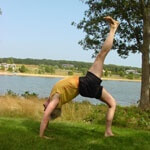“Opening the Shoulders, the Gateway to the Heart”
 By Jayendra Hanley, certified Anusara® Yoga teacher
By Jayendra Hanley, certified Anusara® Yoga teacher
The body is an amazing structure. It contains an “invisible matrix” that is conscious and knows when we are in optimal alignment. When our physical bodies are out of alignment, our energy and mood decline, the muscles harden, the breath gets shallow, and it becomes very difficult to connect with the higher purposes of life – to know the Heart and live from the Heart.
One amazing part of the human body is the shoulder joint and shoulder girdle. The shoulder joint is where the head of the humerus bone enters the scapula or shoulderblade. It is a shallow ball-and-socket joint that is built for maximum freedom and full 360-degree range of motion. This ROM (range of motion) is possible because of the freedom of movement in the shoulderblade. When we move the arm up or back or in any direction, if the shoulderblade is not fixed onto the back with muscular action, it can move in a number of ways to support the ROM of the shoulder.
Why such freedom? Two reasons. First, a free shoulder joint supports the great dexterity and precision of movement found in our hands and fingers. Second, the arms are the gateway to the heart. We reach out to the world from the heart through the arms and hands. The more freedom we have there, the more we can connect both inside to the Heart, and out to the wide world.
In our yoga practice, we can open up the shoulder joint with various asanas, but what we find in Anusara yoga is that the real key to opening the body is not which poses we do; it’s how we do them. Specifically, using Anusara’s Universal Principles of Alignment, which are based on the biomechanics of the human body, we create both structural integration and full range of movement in whatever posture we take. Let’s go over a few of these principles in Tadasana.
The first principle of Anusara yoga is called “Open to Grace”. Standing with your feet hip width apart and parallel, be aware of the area of your heart. In every human heart is supreme Goodness. Practice seeing the Good that is you. Hmmm. When that happens, the inner energy body softly expands. Light radiates from the Heart. In addition, the sides of the body lengthen from the waistline to the armpits, while the outer body, the skin and muscles remain soft. This is first principle, and we can maintain this inner body fullness throughout our practice.
Now bring the arms overhead into Urdhva Hastasana with the hands shoulder width apart and this time, the palms facing forward. The second principle of Anusara Yoga is called Muscular Energy. Move your hands a little forward, then integrate the arms into the shoulder sockets, moving the head of the humerus back. The shoulderblades will move onto the back and in towards the spine. Feel the strength and integration of Muscular Energy. It connects us to an inner power.
Third, keeping the thighs back over the pelvis, keeping the head of the humerus back in the shoulder socket, draw the tailbone down and arch back into a backbend. Allow the gaze to follow the heart as it lifts and opens. The last principle of Anusara is called Organic Energy. From the pelvis, root down into the earth and from the pelvis, rise up with full knowledge of your supreme Goodness. After a few joyful breaths here, exhale and lower your arms down.
The beautiful thing about these Universal Principles of Alignment are first, they work! All over the world, yoga students are discovering how effectively they open the body in an entirely safe way. This becomes particularly important for the shoulders as we start to bear weight on the hands and arms and take them into their full range of motion. The second great thing is that the same principles of alignment apply to all poses. They are Universal!
Poses to practice to open the shoulders:
- Adho Mukha Svanasana: downward facing dog pose
- Bhujangasana: cobra pose
- High lunge or Virabhadrasana 1 with the heel up on the back leg
- Urdhva Mukha Vrksasana: handstand
- Anjaneyasana: “monkey lunge” with the knee of back leg on floor, arms up
- Setubhandasana: baby bridge pose
- Urdhva Dhanurasana: full bridge or wheel pose
